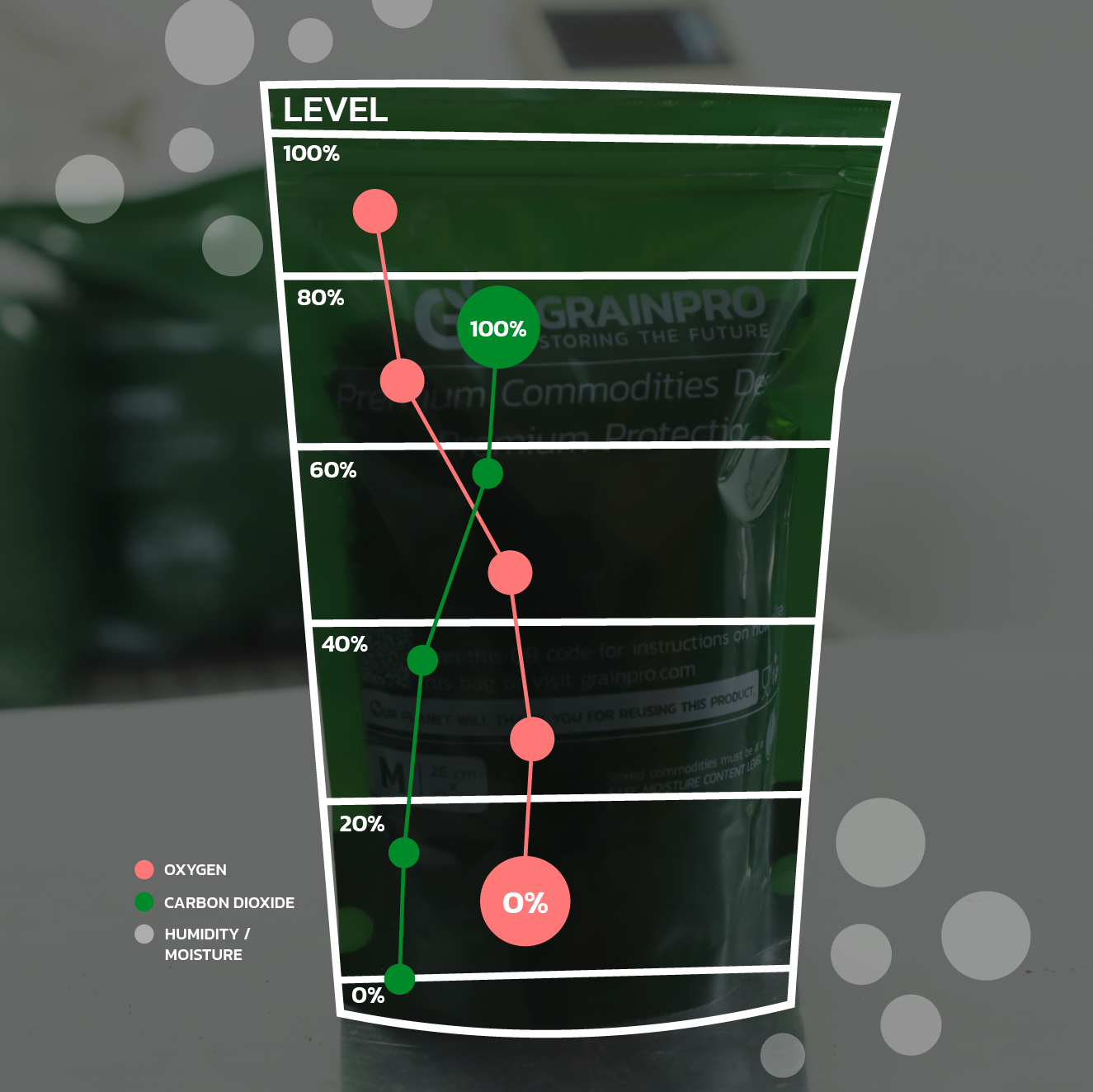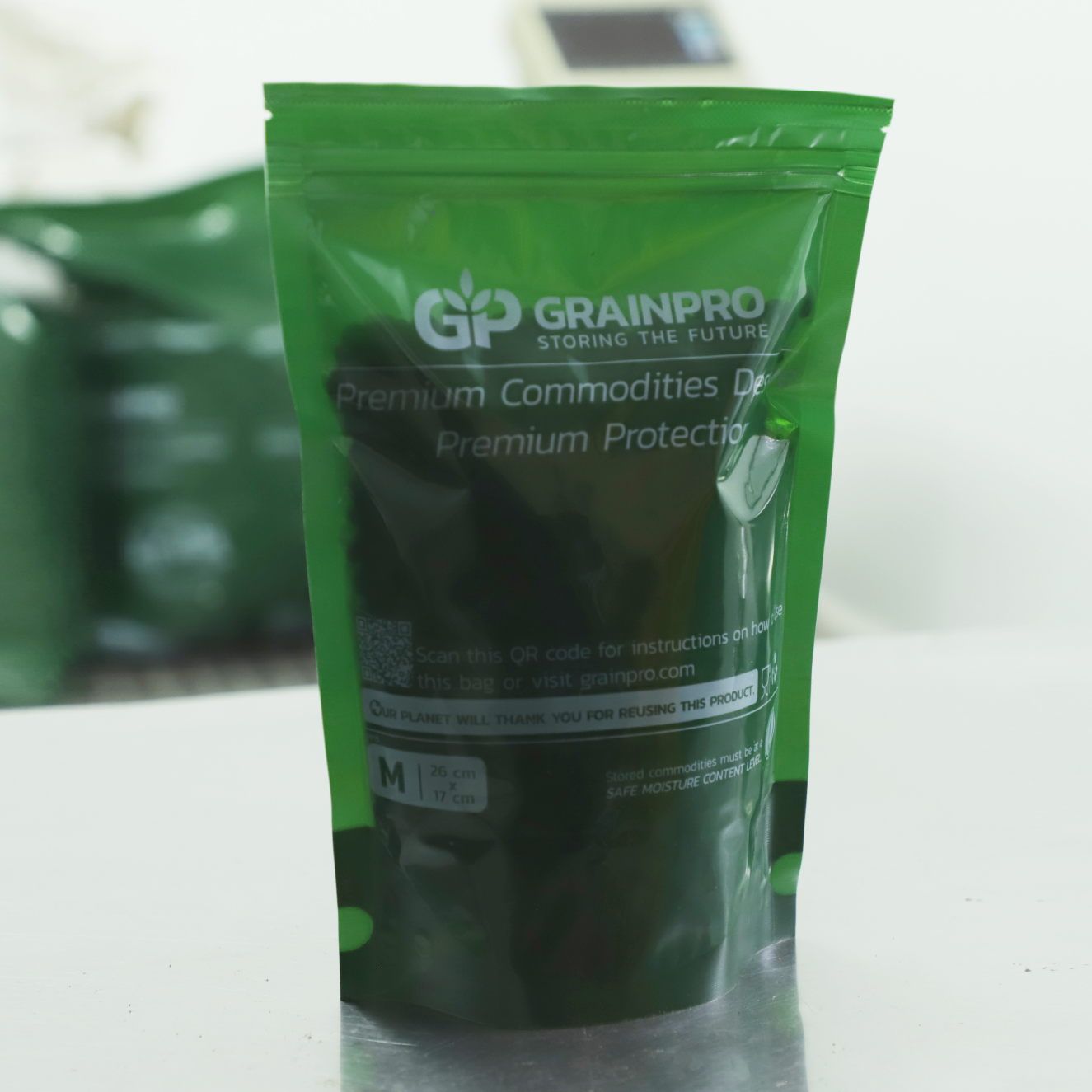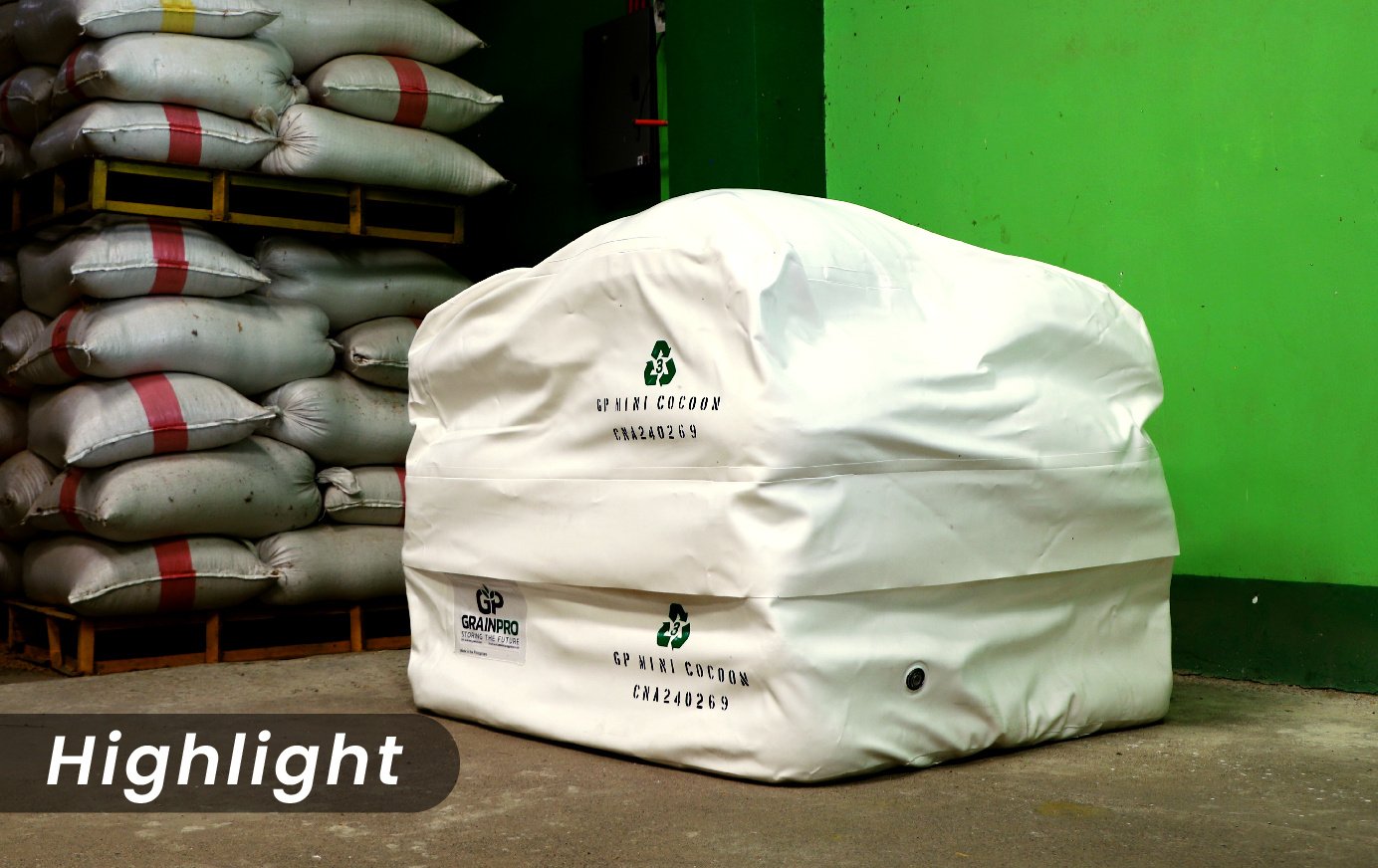THE ULTIMATE BEGINNER’S GUIDE TO
POST-HARVEST HERMETIC TECHNOLOGY
Hermetic technology has long been depended upon because of its simplicity and reliability. Throughout history, this technology has been used in many industries – particularly extensively in agriculture. But what exactly is hermetic technology, and how does it work?
This beginner’s guide to hermetic technology will discuss its basic principles, history, and modern applications. Additionally, real-life examples of its benefits to smallholder farmers and businesses will be cited while showing the importance and effectiveness of hermetic technology in helping resolve food insecurity as a global issue.
THE BASICS
The basis of hermetic technology starts with creating a controlled atmosphere within an air-tight and moisture-tight environment. This provides protection against external factors while preserving the quality internally.
In the case of agricultural applications, hermetic technology is an ideal solution against pest infestation, mold growth, and quality degradation.
When stored commodities are infested with insects, carbon dioxide inside the hermetic container naturally increases while oxygen decreases. This eventually suffocates and kills off insects in all life stages – from eggs to adults


At the same time, the decreased oxygen level inside a hermetic container also inhibits bacterial and fungal or mold growth. Food needs to remain free of mold growth since toxic substances, such aflatoxin, found in mold can lead to serious health issues when ingested. According to WHO, consuming food with high levels of such substances can damage the liver leading to cancer or organ failure, birth defects, and toxicity to the immune system. These substances are known to have ill effects on both humans and livestock.
Hermetic storage utilizes a controlled atmosphere so effectively that the quality of its contents remains in the same state, even during extended storage periods. However, hermetic technology is only applicable to dried commodities. If commodities with high moisture content, such as fresh fruits and vegetables, are placed within a hermetic container, mold will develop and damage will occur.
HISTORY OF HERMETIC TECHNOLOGY IN AGRICULTURE
Hermetic technology is not a new concept. In fact, it was first used during the pre-neolithic and neolithic periods when prehistoric societies began to transition from being nomadic to living in permanent settlements. As these simple settlements flourished into more complex civilizations, agriculture was born. With it, the need for a secure storage system technique arose. Thus, hermetic storage became the norm in the form of underground storage pits.
Researchers in Egypt found 30-100 cm deep underground pits that were lined with straw or bamboo basket weavings. It is thought that grains were then put into the pits and covered with a layer of sand. Similar pits have been found all over the world, such as in the Middle East as well as Europe.

When iron tools were invented, these hermetic underground pits became more varied in depth and shape. Some were found to be bottle-shaped while others were in the shape of a gourd or a pitcher. Despite this range across different continents, experts believe that these hermetic storage pits were effective in keeping food safe from outside elements, insects, and other scavenging animals.
MODERN APPLICATIONS
As technology developed to improve the daily lives of people, so did hermetic technology and its applications to modern agriculture. So, here are some of its most practical and helpful uses:
Quality Preservation
Hermetic technology is most widely used today as cost-effective storage to preserve the quality and quantity of dry agricultural commodities. This is crucial for smallholder farmers and traders who depend on post-harvest storage that can reliably control insect and mold infestations. Hermetically stored commodities have virtually 100% protection from damage brought by insects or molds if the technology is applied correctly.
Commodities stored in GrainPro’s hermetic solutions also exhibit preserved peak quality, which is necessary for high-value commodities such as coffee and cocoa beans. Such is possible even for prolonged storage periods, resulting in preserved aroma, taste, color, and overall quality.
Storage and Treatment for Organic Products
Hermetic storage technology allows farmers to fumigate their organic commodities without using harmful pesticides. This is done by flushing carbon dioxide or nitrogen gas into the hermetic unit via a valve or opening. By doing so, insects are eliminated more quickly while keeping commodities organic.
Safely treating organic commodities is crucial in keeping food products safe while also mitigating the increase of pesticide resistance amongst insects, which has been an escalating problem in recent years due to the improper application of chemical pesticides.
Organic products are seen to be a healthier choice when it comes to daily food consumption. But storage and handling of such products can be a challenge without hermetic technology. With it, however, organic food can remain intact and preserved even during handling or transport. Using certified storage solutions such as the GrainPro Hermetic Bag and Cocoon Indoor, consumers can be sure that their food products remain organic.
Aid in Achieving Food Security
In a study conducted in Bangladesh, rice paddy stored in GrainPro Hermetic Bags and GrainPro Cocoons was found to have significant germination rate retention compared to rice paddy stored in traditional storage containers such as PP bags. Additionally, rice paddy stored within the hermetic containers exhibited lower rates of weight loss. These benefits are crucial when storing staple crops such as rice, maize, and wheat, especially for developing countries at risk of food insecurity.
Dependable storage facilities are also needed to satisfy supply in the long term. Having stockpiled staple crops helps food to be more accessible for populations at risk of severe or prolonged hunger due to conflict, climate disasters, or even poverty. Hermetic technology provides a sustainable storage solution to help combat these issues.
Food safety is also strengthened using hermetic storage since no mold growth can occur if crops are adequately dried, handled, and stored. This ensures that food is free from aflatoxins and retains nutrients. Countries with populations vulnerable to aflatoxin can benefit highly from this, especially those in rural areas wherein people are reliant on subsistence agriculture.
Climate Change Mitigation
Extreme weather events have become frequent in recent years, and the agricultural sector has been severely affected–more often in developing countries. This is because smallholder farmers in such countries still widely use traditional methods when handling their harvested crops. Unfortunately, even stored commodities are prone to damage due to sudden rainfall or flash floods.
Insect activity has also increased due to rising global temperatures since insects are ectothermic, meaning the temperature in their environment directly affects their growth, reproduction patterns, and metabolic rates. Simply put: the high temperatures increase the metabolic rates of insects, making them eat more and reproduce more.
In 2020, farmers in East Africa feared for their livelihoods due to the threat of a locust plague triggered by above-average rainfall from the previous year. Thanks to technology and the quick action from governments and NGOs, losses amounting to $1.5 trillion worth of agricultural products were averted, as stated by the FAO.
The resolution of this near-catastrophe shows that technology should be integrated into solving agricultural issues. And thanks to hermetic technology, more and more farmers are learning the benefits of being climate-smart for their post-harvest storage.
Secure Transit
Hermetic technology is also a big help in transporting dry commodities during transoceanic journeys. Keeping commodities in a hermetically-sealed container minimizes the damage that condensation can cause. This is particularly useful for high-value commodities shipped in bulk, so unexpected delays like the 2021 Suez Canal blockage won’t be detrimental to businesses.
However, even bagged commodities stored in PP sacks or jute bags are vulnerable to damage during transit. Condensation regularly occurs and “rains” down on the contents of a shipping container, often leading to mold growth and spoilage. This can happen to coffee beans, spices, and other valuable commodities. To prevent this, container liners that are gas- and moisture-tight can be utilized. This way, an added layer of barrier protects the commodities being transported. Moreover, any insects embedded within the commodities will eventually be eliminated, ensuring no infestation will spread.
GRAINPRO HERMETIC TECHNOLOGY AROUND THE WORLD
The basis of hermetic technology starts with creating a controlled atmosphere within an air-tight and moisture-tight environment. This provides protection against external factors while preserving the quality internally.
Smallholder farmers in Kenya, Africa began using hermetic solutions and saw positive results in maintaining crop quality. One farmer noticed this and reported that GrainPro’s hermetic bags kept him from losing 30% of his harvest. This is extremely favorable to smallholder farmers since they can invest more in their farms and improve the daily lives of their families. By storing their crops safely, they retain better quality and can sell after the harvest season at higher prices.
Additionally, smallholder farmers no longer have to rely on harmful chemical preservatives, reducing costs while boosting the nutritional value of their crops. Using hermetic storage helps farmers earn more profits and provide safer food for their families.
In Nigeria, a social enterprise called Babban Gona has massively scaled up their farmer cooperative operations with the help of large-capacity hermetic storage. They provide training, credit, agricultural inputs, and marketing services to smallholder farmers all the while securing grains to preserve both quality and quantity. More importantly, Babban Gona provides job security for farmers, helping create stability in an otherwise conflict-laden area through agriculture.
Farmers in Pakistan began to use seeds and hermetic storage provided by Haji Sons and soon saw their profits increase by up to 25%. The red chili peppers they stored in GrainPro bags retained color and shine, did not develop molds, and were insect-free. This attracted premium buyers and resulted in double benefits for the farmers. The increase in profits that farmers are experiencing is a significant development for Pakistan’s rural residents, who account for more than 80% of the country’s poor.
Fundación Tortilla founded by Rafael Mier, has been working hard to preserve one of the roots of Mexican culture: tortillas. But Rafael quickly found that maize, the main ingredient of tortillas, was prone to insect infestation and damage from the hot and humid Mexican climate. This prompted Rafael to look for solutions and discovered hermetic technology. He learned that coffee growers use GrainPro bags to preserve the quality of their beans, and he knew friends who used the bags to export grains to the US to ensure their products arrived safely.
Fundación Tortilla has since started promoting GrainPro bags to those who take in-person and online classes on improving the state of maize in Mexico.
In Honduras, Diana Osorto has worked with the International Women’s Coffee Alliance to help empower women smallholder coffee farmers. By promoting hermetic technology to rural women and their communities in general, Diana observed that they learn how to preserve the quality of their coffee beans, fight food insecurity, and increase their household incomes. At the same time, women in agriculture help take care of their land the way they care for their families.
HERMETIC TECHNOLOGY IN A NUTSHELL
To sum up, hermetic technology is a reliable and time-tested means of securing dry agricultural commodities. In a world with pressing issues like food insecurity, climate change, and conflict, it’s important to ensure that no food is wasted or lost due to preventable erratic factors, poor handling, and mismanagement.
A shift towards sustainable, cost-effective, and climate-smart agricultural solutions, such as hermetic storage, is pivotal in achieving food security. More importantly, as the backbone of agriculture, smallholder farmers must be given more support to help them grow, harvest, and process healthy, wholesome food. As it allows the safe and long-term preservation of dry agricultural commodities, hermetic storage boosts profitability by giving our smallholder farmers a chance to sell during a more favorable season. Through technology, education, and cooperation, smallholder farmers can have the means to prosper and be rewarded for their hard work in making sure that there will be no more hunger in the world.
Want an e-book version of this page with additional data and insights on hermetic technology?
Download your copy by clicking the button below.



